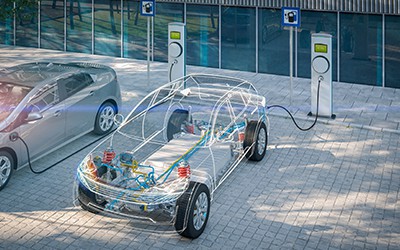DECARBONIZATION
Key Trends in Modern Vehicle Electrical and Electronic Architectures
Overview
As the e-Mobility space continues to evolve, the overall trend in automotive electrical and electronic architecture is moving into a new phase. The proliferation of in-vehicle applications has led to dramatic increases in the use of advanced electronics across various functional areas. However, the need to improve performance, safety, efficiency, and driver experience is now driving an evolution of EE architecture approaches from decentralized structure towards more centralized by domain and zonal implementation.
This article provides an overview of the factors that are driving increased on-board electronics usage with a focus on the over-arching trends in EE architecture design and implementation technologies.
The Unrelenting Rise of In-Vehicle Electronics
A variety of specific application areas are accelerating the usage of advanced electrical and electronic technologies throughout modern vehicles.
Some of these major factors include:
Some of these major factors include:

INCREASED USE OF ADVANCED DRIVER ASSISTANCE SYSTEMS (ADAS)
ADAS technology is becoming increasingly popular and is driving the demand for a wider range of sensors, such as cameras, LiDAR, and radar. These sensors are used to enable higher level of autonomous driving, improving safety and driving comfort.

ADVANCEMENTS IN ELECTRIC AND AUTONOMOUS VEHICLES
Electric and autonomous vehicles require more sensors and electronics to support the advanced technologies used to power and control these vehicles. This includes applications for battery management, vehicle control, and obstacle detection.

MINIATURIZATION AND COST REDUCTION
Automotive electronics are becoming smaller and more affordable, making them accessible to a wider range of vehicles and applications. This is helping to drive the trend towards the use of advanced electronics in more types of vehicles.

INTEGRATION OF MULTIPLE SENSORS
Vehicles are increasingly using multiple sensors to enhance their capabilities, and these sensors are becoming more integrated into the vehicle’s overall systems. This integration is leading to a more seamless user experience and improved performance.

V2X, V2V AND 5G COMMUNICATIONS
The increasing deployment of applications requiring connectivity is driving usage of Vehicle-to-Everything (V2X), Vehicle-to-Vehicle (V2V) and 5G connections that add complexity but are critical for vehicle operation, safety, and consumer adoption.

EVOLUTION OF INFOTAINMENT AND COMMUNICATIONS SYSTEMS
As ADAS and autonomous driving systems take much of the load off drivers, the rise of sophisticated information, entertainment and communications is taking on a major role to enhance the experiences for both drivers and riders.
Evolution of Automotive EE Architecture Approaches
Along with the proliferation of automotive electronics and electrical applications, there is an evolution underway regarding the overall EE architecture approach to interconnecting and integrating on-board systems, which will result in sweeping changes over the next 2-3 years.
The EE architecture changes will encompass three key areas of:
With the rise of more complex and sophisticated functionality and the need for low-latency, real-time responsiveness, key EE architecture challenges revolve around the diversity of functions and the increasing complexity of sensors spread throughout the vehicle that need to interact with centralized ECU controllers.
As shown below, automotive EE architectures are evolving toward greater centralization as they move from the domain architecture with Domain Control Units (DCUs) that locally manage functions such as autonomous driving domain, smart cockpit domain, body control domain, etc., toward the zonal architecture which ultimately combines all functions in powerful central computers.
The EE architecture changes will encompass three key areas of:
- Hardware architectures
- Software architectures
- Communications architectures
With the rise of more complex and sophisticated functionality and the need for low-latency, real-time responsiveness, key EE architecture challenges revolve around the diversity of functions and the increasing complexity of sensors spread throughout the vehicle that need to interact with centralized ECU controllers.
As shown below, automotive EE architectures are evolving toward greater centralization as they move from the domain architecture with Domain Control Units (DCUs) that locally manage functions such as autonomous driving domain, smart cockpit domain, body control domain, etc., toward the zonal architecture which ultimately combines all functions in powerful central computers.

Figure 1 – Evolution of Automotive EE Architecture

Figure 2 – Increasing Complexity of Domain/Zonal Functions in Vehicles
Key Enabling Technologies to Support EE Architecture Evolution
As a decades-long, trusted supplier of electrical and electronic solutions for the automotive industry, Interplex is once again helping lead the way in technology innovations to enable the ongoing EE architecture evolution.
Some key examples are as follows.
Some key examples are as follows.
Sensor Interconnects – as sensors proliferate throughout new EE architecture environments, the need for both higher performance and smaller form factors is more critical than ever. Interplex addresses these frontline sensor challenges through a series of robust, customizable interconnect modules designed to support a variety of sensor types, such as LiDAR and RADAR across a wide range of decentralized and zonal applications.

Figure 3 – Interplex Radar Interconnect and LiDAR Interconnect
High-Pin-Count Headers – with data flows and signal densities dramatically increasing between sensors, controllers and actuators, the ability to provide high pin-counts within modules and across domains is a critical factor in EE architecture evolution. Interplex leads the industry in the provision of configurable high-pin-count headers.

Figure 4 – Interplex High-Pin-Count Headers
Integrated Connector Housings – tightly integrated connector housings are vital to success of new centralized EE architecture ecosystems. High-speed movement of huge amounts of data between sensors, DCUs and actuators in distributed zones and also cross-communication from zones to central ECUs depends on having robust tightly integrated connector technologies.

Figure 5 – Interplex Integrated Connector Housing
Multi-row Board-to-Board Connectors – with more features and higher performance needed throughout new domain and zonal centralized EE architecture, the ability to increase circuit density while minimizing module size is a key factor for success. Interplex’s innovative leadership in compact, multi-row connectors enable module designers to cost-effectively integrate multi-PCB assemblies for optimal performance and robust lifecycles.

Figure 6 – Interplex Multi-Row Board-to-Board Connector
Summary
As next-gen automotive electrical and electronic architectures evolve away from traditional hub-and-spoke configurations towards all sensors connecting to centralized ECUs, new EE architecture ecosystems will enable more efficient and intelligent distributed zonal domains to support low-latency local responsiveness. These networked zone-distributed environments will provide greater flexibility and scalability without compromising performance.
In helping lead the way for supporting creation of new EE architecture environments, Interplex has adopted a paradigm called “Sense, Think, Act” that acknowledges how automotive systems are evolving to be much like living organisms that need to Sense the surrounding and in cabin environment, to Think in order to make the best decisions, and to Act in real time for avoiding hazards and achieving desired results. Just as organisms have developed specialized systems that can act quickly to a wide range of stimuli, new EE architectures are moving in a similar direction.
In helping lead the way for supporting creation of new EE architecture environments, Interplex has adopted a paradigm called “Sense, Think, Act” that acknowledges how automotive systems are evolving to be much like living organisms that need to Sense the surrounding and in cabin environment, to Think in order to make the best decisions, and to Act in real time for avoiding hazards and achieving desired results. Just as organisms have developed specialized systems that can act quickly to a wide range of stimuli, new EE architectures are moving in a similar direction.

Figure 7 – Sense, Think, Act for Autonomous Driving
By using a holistic end-to-end design approach along with targeted focus on the critical performance areas in these new EE architectures, we are able to provide advanced, customizable solutions to help our customers optimize performance, functionality, and time-to-market while reducing product cost and the Total Cost of Ownership.




